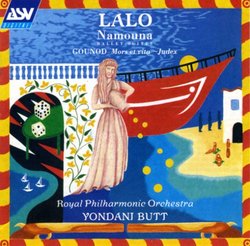| All Artists: Edouard Lalo, Charles Gounod, Yondani Butt, Royal Philharmonic Orchestra Title: Lalo: Namouna; Gounod: Mors et vita; Judex Members Wishing: 0 Total Copies: 0 Label: Asv Living Era Release Date: 3/22/1994 Genre: Classical Styles: Opera & Classical Vocal, Ballets & Dances, Ballets, Symphonies Number of Discs: 1 SwapaCD Credits: 1 UPC: 743625087826 |
Search - Edouard Lalo, Charles Gounod, Yondani Butt :: Lalo: Namouna; Gounod: Mors et vita; Judex
 | Edouard Lalo, Charles Gounod, Yondani Butt Lalo: Namouna; Gounod: Mors et vita; Judex Genre: Classical
|
Larger Image |
CD Details |
CD ReviewsExcellent performance of a neglected composer 10/11/1998 (5 out of 5 stars) "The ballet suite Namouna is memorable music by a late 19th century french composer who is now largely neglected. He has a very distinctive and tuneful style and was greatly admired by Claude Debussy. I recommend it to anyone who likes to discover lost gems, Yondani Butt is a sympathetic conductor who shows off the music to advantage" Debussy Was Right M. C. Passarella | Lawrenceville, GA | 12/16/2007 (5 out of 5 stars) "Sensuous and exotic, especially by Parisian standards in 1882, Lalo's Namouna was a hit with those in the know. This included the then 19-year-old student of the Conservatoire Claude Debussy, who became so vociferous in his acclamation of Lalo's music that the board of l'Opera, where the work was first performed, moved to exclude Conservatoire students from performances at the august venue. So why isn't Namouna performed today? As with most 19th-century operas and ballets, the answer lies with the program. Namouna, a slave girl, is lost in a bet by her owner, an inveterate gambler. The guy who wins her in the crapshoot sets her free and, after some fairly predictable subplot shenanigans, she falls for the mug. The end.
All right, so we aren't going to see Namouna mounted anytime soon by the New York City Ballet. But fortunately, we can enjoy the work on this ASV CD; it is fully worthy of your attention. It starts in grand fashion with a Prelude that frankly seems suited for grander doings than the storyline of Namouna. At any rate, we can see why Parisian critics sneered at Lalo as a Wagnerian, even if he sneered back that he disliked Wagner intensely. The Prelude builds to a, well, Wagnerian climax, with stentorian brass over pearling harps--a very impressive start. But the rest of the ballet is pure French champagne with a touch of Latin bitters. After all, Lalo's family hailed from Spain. Some of the music is so light as to border on the frivolous ("Fete foraine," "Pas des cymbales"), but that's true of Lalo's great contemporary Delibes. The best of the music, including "Danse des esclaves," "Dolce far niente," and the frankly sexy "Valse de la Cigarette" justify Debussy's youthful enthusiasm. My favorite is "Dolce far niente," with its quiet harp harmonics and soft taps on the tambourine, introducing a sinuous little melody of real charm. The rhythms and orchestral color bespeak Lalo's Spanish roots, even if the ballet is set in the Greek Isles. This is mostly an admirable recording of the work, but I have a couple of small criticisms. First, it includes only the two suites Lalo extracted from the ballet. As I recall from a first-rate recording by Jean Martinon on DG (long out of print), the complete ballet has other goodies that could have been included in this recording. "Judex" from Gounod's "Mors et Vita" is a pure afterthought. It is an orchestral excerpt from a religiously minded choral work and really has no place on this disc, mildly attractive though it may be. Why not more of Namouna? Second, the recording is really spectacular, the prominent brass and percussion given their due. However, the string sound is somewhat hard and opaque, probably the result of too close miking. But this was ASV's recording style, and of its kind (up close and personal) it's well done because Henry Wood Hall, a fine recording venue, adds enough air that the sound of the full orchestra is nicely open. And this is a minor quibble anyway. It is good to have Namouna brought to life in such a sympathetic performance--and in bigger-than-life sound." |

 Track Listings (12) - Disc #1
Track Listings (12) - Disc #1